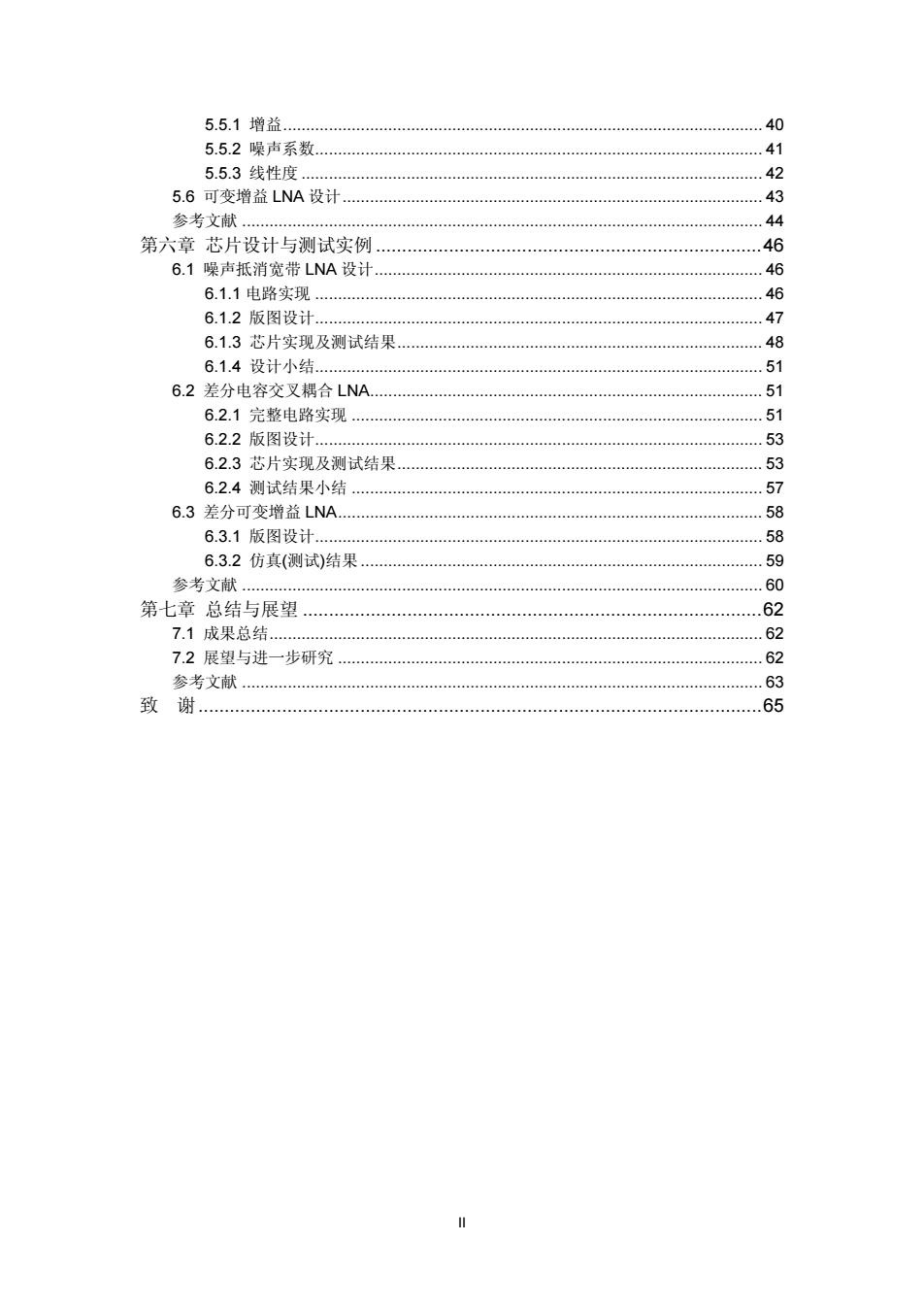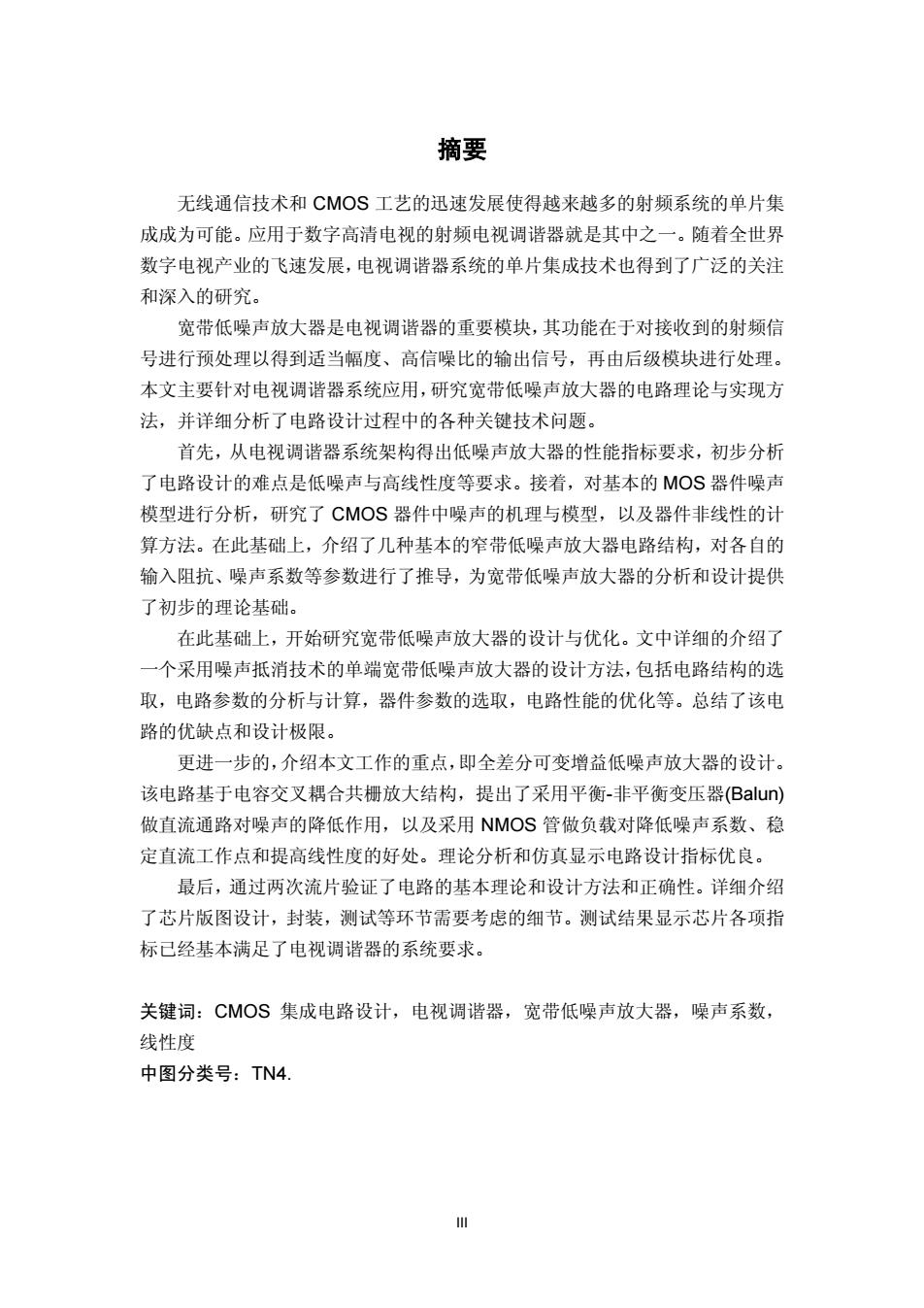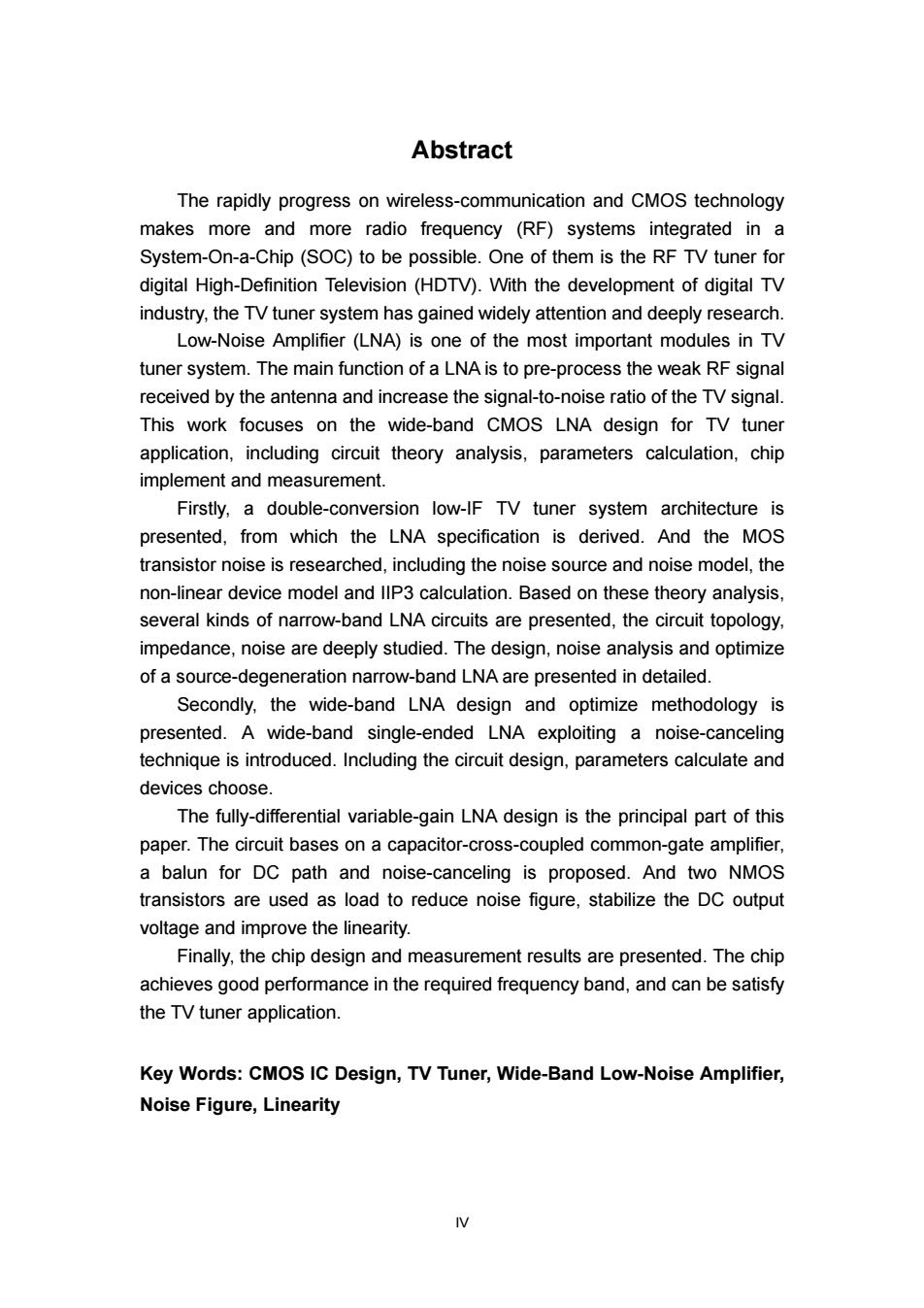
学校代码:10246 学号:042052031 復旦大婴 硕士学位论文 CMOS宽带低噪声放大器的研究与设计 院 系: 信息科学与工程学院 专 业: 微电子学与固体电子学 姓 名: 廖友春 指导教师: 唐长文闵昊 完成日期: 2007年7月4日
学校代码: 10246 学 号: 042052031 硕 士 学 位 论 文 CMOS 宽带低噪声放大器的研究与设计 院 系: 信息科学与工程学院 专 业: 微电子学与固体电子学 姓 名: 廖友春 指 导 教 师: 唐长文 闵 昊 完 成 日 期: 2007 年 7 月 4 日

目 录 目 录 .1 摘要 Abstract..... IV 第一章概述 .1 1.1数字电视调谐器系统.… 1 1.2低噪声放大器..… 3 1.3论文研究内容及贡献, 4 1.4论文组织结构… .5 参考文献 5 第二章MOS管噪声模型 8 2.1沟道电流热噪声… 8 2.2栅噪声(准静态模型) .8 2.3栅噪声与沟道噪声的相关性 .10 2.4MOS器件非线性模型.… .11 参考文献… 12 第三章窄带LNA电路设计与优化 .13 3.1四种基本窄带LNA结构及噪声分析 3 3.1.1栅极匹配电阻型共源结构.… 13 3.1.2电阻反馈型共源结构. .14 3.13共栅放大结构…。 .14 3.1.4带源极电感反馈的共源结构 .15 3.2源极电感反馈型LNA噪声分析.. .16 3.2.1简约模型(忽略感应栅噪声)… 16 3.2.2完整模型(包括感应栅噪声) 19 3.3噪声优化 .23 3.3.1固定增益求最小噪声系数… 25 3.3.2固定功耗求最小噪声系数。 26 参考文献… 26 第四章噪声抵消LNA的设计方法 28 4.1噪声抵消原理. .28 4.2噪声系数计算.… .31 4.3线性度分析 32 4.4各参数间的权衡关系. .32 参考文献 33 第五章差分可变增益LNA设计 34 5.1电容交叉耦合LNA基本结构 .34 5.2输入端设计 36 5.3理想Balun特性, .36 5.4负载设计. .39 5.5电路参数计算.… .40
I 目 录 目 录 ...........................................................................................................I 摘要.................................................................................................................III Abstract.......................................................................................................... IV 第一章 概述.....................................................................................................1 1.1 数字电视调谐器系统............................................................................................ 1 1.2 低噪声放大器....................................................................................................... 3 1.3 论文研究内容及贡献............................................................................................ 4 1.4 论文组织结构 ....................................................................................................... 5 参考文献 .................................................................................................................... 5 第二章 MOS 管噪声模型 .................................................................................8 2.1 沟道电流热噪声................................................................................................... 8 2.2 栅噪声(准静态模型) ............................................................................................. 8 2.3 栅噪声与沟道噪声的相关性 ............................................................................... 10 2.4 MOS 器件非线性模型..........................................................................................11 参考文献 .................................................................................................................. 12 第三章 窄带 LNA 电路设计与优化 .................................................................13 3.1 四种基本窄带 LNA 结构及噪声分析................................................................... 13 3.1.1 栅极匹配电阻型共源结构......................................................................... 13 3.1.2 电阻反馈型共源结构................................................................................ 14 3.1.3 共栅放大结构 .......................................................................................... 14 3.1.4 带源极电感反馈的共源结构..................................................................... 15 3.2 源极电感反馈型 LNA 噪声分析.......................................................................... 16 3.2.1 简约模型(忽略感应栅噪声) ...................................................................... 16 3.2.2 完整模型(包括感应栅噪声) ...................................................................... 19 3.3 噪声优化............................................................................................................ 23 3.3.1 固定增益求最小噪声系数......................................................................... 25 3.3.2 固定功耗求最小噪声系数......................................................................... 26 参考文献 .................................................................................................................. 26 第四章 噪声抵消 LNA 的设计方法 .................................................................28 4.1 噪声抵消原理..................................................................................................... 28 4.2 噪声系数计算..................................................................................................... 31 4.3 线性度分析 ........................................................................................................ 32 4.4 各参数间的权衡关系.......................................................................................... 32 参考文献 .................................................................................................................. 33 第五章 差分可变增益 LNA 设计.....................................................................34 5.1 电容交叉耦合 LNA 基本结构............................................................................. 34 5.2 输入端设计 ........................................................................................................ 36 5.3 理想 Balun 特性................................................................................................. 36 5.4 负载设计............................................................................................................ 39 5.5 电路参数计算..................................................................................................... 40

5.5.1增益… .40 5.5.2噪声系数 41 5.5.3线性度 42 5.6可变增益LNA设计 43 参考文献… .44 第六章芯片设计与测试实例 .46 6.1噪声抵消宽带LNA设计 .46 6.1.1电路实现… 46 6.1.2版图设计.… 47 6.1.3芯片实现及测试结果 48 6.1.4设计小结… 51 6.2差分电容交叉耦合LNA 51 6.2.1完整电路实现… 51 6.2.2版图设计..… .53 6.2.3芯片实现及测试结果 .53 6.2.4测试结果小结 .57 6.3差分可变增益LNA… .58 6.3.1版图设计. 58 6.3.2仿真(测试)结果 59 参考文献 60 第七章总结与展望 62 71成果总结… 62 7.2展望与进一步研究 .62 参考文献… .63 致谢. .65
II 5.5.1 增益......................................................................................................... 40 5.5.2 噪声系数.................................................................................................. 41 5.5.3 线性度 ..................................................................................................... 42 5.6 可变增益 LNA 设计............................................................................................ 43 参考文献 .................................................................................................................. 44 第六章 芯片设计与测试实例..........................................................................46 6.1 噪声抵消宽带 LNA 设计..................................................................................... 46 6.1.1 电路实现 .................................................................................................. 46 6.1.2 版图设计.................................................................................................. 47 6.1.3 芯片实现及测试结果................................................................................ 48 6.1.4 设计小结.................................................................................................. 51 6.2 差分电容交叉耦合 LNA...................................................................................... 51 6.2.1 完整电路实现 .......................................................................................... 51 6.2.2 版图设计.................................................................................................. 53 6.2.3 芯片实现及测试结果................................................................................ 53 6.2.4 测试结果小结 .......................................................................................... 57 6.3 差分可变增益 LNA............................................................................................. 58 6.3.1 版图设计.................................................................................................. 58 6.3.2 仿真(测试)结果........................................................................................ 59 参考文献 .................................................................................................................. 60 第七章 总结与展望 ........................................................................................62 7.1 成果总结............................................................................................................ 62 7.2 展望与进一步研究 ............................................................................................. 62 参考文献 .................................................................................................................. 63 致 谢............................................................................................................65

摘要 无线通信技术和CMOS工艺的迅速发展使得越来越多的射频系统的单片集 成成为可能。应用于数字高清电视的射频电视调谐器就是其中之一。随着全世界 数字电视产业的飞速发展,电视调谐器系统的单片集成技术也得到了广泛的关注 和深入的研究。 宽带低噪声放大器是电视调谐器的重要模块,其功能在于对接收到的射频信 号进行预处理以得到适当幅度、高信噪比的输出信号,再由后级模块进行处理。 本文主要针对电视调谐器系统应用,研究宽带低噪声放大器的电路理论与实现方 法,并详细分析了电路设计过程中的各种关键技术问题。 首先,从电视调谐器系统架构得出低噪声放大器的性能指标要求,初步分析 了电路设计的难点是低噪声与高线性度等要求。接着,对基本的MOS器件噪声 模型进行分析,研究了CMOS器件中噪声的机理与模型,以及器件非线性的计 算方法。在此基础上,介绍了几种基本的窄带低噪声放大器电路结构,对各自的 输入阻抗、噪声系数等参数进行了推导,为宽带低噪声放大器的分析和设计提供 了初步的理论基础。 在此基础上,开始研究宽带低噪声放大器的设计与优化。文中详细的介绍了 一个采用噪声抵消技术的单端宽带低噪声放大器的设计方法,包括电路结构的选 取,电路参数的分析与计算,器件参数的选取,电路性能的优化等。总结了该电 路的优缺点和设计极限。 更进一步的,介绍本文工作的重点,即全差分可变增益低噪声放大器的设计。 该电路基于电容交叉耦合共栅放大结构,提出了采用平衡-非平衡变压器(Balun) 做直流通路对噪声的降低作用,以及采用NMOS管做负载对降低噪声系数、稳 定直流工作点和提高线性度的好处。理论分析和仿真显示电路设计指标优良。 最后,通过两次流片验证了电路的基本理论和设计方法和正确性。详细介绍 了芯片版图设计,封装,测试等环节需要考虑的细节。测试结果显示芯片各项指 标己经基本满足了电视调谐器的系统要求。 关键词:CMOS集成电路设计,电视调谐器,宽带低噪声放大器,噪声系数, 线性度 中图分类号:TN4
III 摘要 无线通信技术和 CMOS 工艺的迅速发展使得越来越多的射频系统的单片集 成成为可能。应用于数字高清电视的射频电视调谐器就是其中之一。随着全世界 数字电视产业的飞速发展,电视调谐器系统的单片集成技术也得到了广泛的关注 和深入的研究。 宽带低噪声放大器是电视调谐器的重要模块,其功能在于对接收到的射频信 号进行预处理以得到适当幅度、高信噪比的输出信号,再由后级模块进行处理。 本文主要针对电视调谐器系统应用,研究宽带低噪声放大器的电路理论与实现方 法,并详细分析了电路设计过程中的各种关键技术问题。 首先,从电视调谐器系统架构得出低噪声放大器的性能指标要求,初步分析 了电路设计的难点是低噪声与高线性度等要求。接着,对基本的 MOS 器件噪声 模型进行分析,研究了 CMOS 器件中噪声的机理与模型,以及器件非线性的计 算方法。在此基础上,介绍了几种基本的窄带低噪声放大器电路结构,对各自的 输入阻抗、噪声系数等参数进行了推导,为宽带低噪声放大器的分析和设计提供 了初步的理论基础。 在此基础上,开始研究宽带低噪声放大器的设计与优化。文中详细的介绍了 一个采用噪声抵消技术的单端宽带低噪声放大器的设计方法,包括电路结构的选 取,电路参数的分析与计算,器件参数的选取,电路性能的优化等。总结了该电 路的优缺点和设计极限。 更进一步的,介绍本文工作的重点,即全差分可变增益低噪声放大器的设计。 该电路基于电容交叉耦合共栅放大结构,提出了采用平衡-非平衡变压器(Balun) 做直流通路对噪声的降低作用,以及采用 NMOS 管做负载对降低噪声系数、稳 定直流工作点和提高线性度的好处。理论分析和仿真显示电路设计指标优良。 最后,通过两次流片验证了电路的基本理论和设计方法和正确性。详细介绍 了芯片版图设计,封装,测试等环节需要考虑的细节。测试结果显示芯片各项指 标已经基本满足了电视调谐器的系统要求。 关键词:CMOS 集成电路设计,电视调谐器,宽带低噪声放大器,噪声系数, 线性度 中图分类号:TN4

Abstract The rapidly progress on wireless-communication and CMOS technology makes more and more radio frequency (RF)systems integrated in a System-On-a-Chip (SOC)to be possible.One of them is the RF TV tuner for digital High-Definition Television(HDTV).With the development of digital TV industry,the TV tuner system has gained widely attention and deeply research. Low-Noise Amplifier(LNA)is one of the most important modules in TV tuner system.The main function of a LNA is to pre-process the weak RF signal received by the antenna and increase the signal-to-noise ratio of the TV signal. This work focuses on the wide-band CMOS LNA design for TV tuner application,including circuit theory analysis,parameters calculation,chip implement and measurement. Firstly,a double-conversion low-IF TV tuner system architecture is presented,from which the LNA specification is derived.And the MOS transistor noise is researched,including the noise source and noise model,the non-linear device model and IIP3 calculation.Based on these theory analysis, several kinds of narrow-band LNA circuits are presented,the circuit topology, impedance,noise are deeply studied.The design,noise analysis and optimize of a source-degeneration narrow-band LNA are presented in detailed. Secondly,the wide-band LNA design and optimize methodology is presented.A wide-band single-ended LNA exploiting a noise-canceling technique is introduced.Including the circuit design,parameters calculate and devices choose. The fully-differential variable-gain LNA design is the principal part of this paper.The circuit bases on a capacitor-cross-coupled common-gate amplifier, a balun for DC path and noise-canceling is proposed.And two NMOS transistors are used as load to reduce noise figure,stabilize the DC output voltage and improve the linearity. Finally,the chip design and measurement results are presented.The chip achieves good performance in the required frequency band,and can be satisfy the TV tuner application. Key Words:CMOS IC Design,TV Tuner,Wide-Band Low-Noise Amplifier, Noise Figure,Linearity N
IV Abstract The rapidly progress on wireless-communication and CMOS technology makes more and more radio frequency (RF) systems integrated in a System-On-a-Chip (SOC) to be possible. One of them is the RF TV tuner for digital High-Definition Television (HDTV). With the development of digital TV industry, the TV tuner system has gained widely attention and deeply research. Low-Noise Amplifier (LNA) is one of the most important modules in TV tuner system. The main function of a LNA is to pre-process the weak RF signal received by the antenna and increase the signal-to-noise ratio of the TV signal. This work focuses on the wide-band CMOS LNA design for TV tuner application, including circuit theory analysis, parameters calculation, chip implement and measurement. Firstly, a double-conversion low-IF TV tuner system architecture is presented, from which the LNA specification is derived. And the MOS transistor noise is researched, including the noise source and noise model, the non-linear device model and IIP3 calculation. Based on these theory analysis, several kinds of narrow-band LNA circuits are presented, the circuit topology, impedance, noise are deeply studied. The design, noise analysis and optimize of a source-degeneration narrow-band LNA are presented in detailed. Secondly, the wide-band LNA design and optimize methodology is presented. A wide-band single-ended LNA exploiting a noise-canceling technique is introduced. Including the circuit design, parameters calculate and devices choose. The fully-differential variable-gain LNA design is the principal part of this paper. The circuit bases on a capacitor-cross-coupled common-gate amplifier, a balun for DC path and noise-canceling is proposed. And two NMOS transistors are used as load to reduce noise figure, stabilize the DC output voltage and improve the linearity. Finally, the chip design and measurement results are presented. The chip achieves good performance in the required frequency band, and can be satisfy the TV tuner application. Key Words: CMOS IC Design, TV Tuner, Wide-Band Low-Noise Amplifier, Noise Figure, Linearity